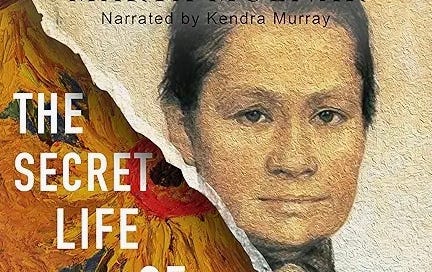BookLife Review by Carol O’Day:The Secret Life of Sunflowers (Marta Molnar, author)
Historical fiction Johanna Van Gogh-Bonger, Vincent and Theo Van Gogh, Impressionists, Amsterdam, Paris, dual time line novel, auctioneer, artists, grandmother-granddaughter, family secrets, romance
More than half of this book is fascinating. The Secret Life of Sunflowers tells the story of the life of Johanna Van Gogh-Bonger. Johanna was the wife of Theo Van Gogh, and after the death of her husband and brother-in-law, she became the custodian of a vast collection of the unsung and unsold works of Vincent Van Gogh. She was fiercely determined to become Vicent’s agent and the advocate for his work. She believed in his talent as a painter; she also was determined to carry out the legacy of her beloved husband, Theo, who’s primary life’s work was making the world see and appreciate Vincent’s genius.
Unfortunately, the author, Marta Molnar, feels compelled to add a modern storyline to the story of Johanna and creates a dual timeline novel, splitting the narrative between Johanna’s story and that of a wholly fictional modern woman, Emsley Wilson. Emsley is an auctioneer and moves in the world of celebrity and political fundraising auctions. Her primary relationship is with her grandmother, Violet, a famous artist and Emsley’s biggest champion. Violet has secrets which Emsley is left to decipher after her death as Violet’s sole heir. Among the secrets is a box of letters written in Dutch and a diary of sorts, written in English. The diary is the portal through which we learn Johanna’s story.
Johanna’s story is an untold story of women’s history and a piece of art history unknown to most, perhaps. While Johanna faces the expected challenges of simply being female in her era and in the art world, where women were “not permitted” to act as art agents or brokers, she alsofaces the added challenge of being a young widow and single mother. She finds support in her childhood friend who encourages her to open a boarding house, and a community of intellectuals and craftsmen who support her desire to bring Vincent’s art to the world. She is multi-lingual and undertakes work as a translator to support herself and her young son. The historical portion of the novel is strong, and compelling; the reader knows that someone succeeds in bringing Vincent Van Gogh’s art to the public realm, and assumes Johanna as the custodian of his work must have had a role. The mystery is where she finds a foothold. How does she succeed? Who ultimately gives her a break, an opportunity to share his work?
The secondary story, of Emsley, is less compelling. It pales in comparison to Johanna’s. Emsley’s grandmother is in a nursing facility when the story opens, recovering from a stroke. She has a box she wants to give Johanna, full of Dutch letters and a diary in English, and Emsley takes only the diary at first. Despite her feisty persona, we suspect early on that Violet may not be around long. She dies before all the secrets are told, of course, and the unraveling of her secrets is left to Emsley. Molnar feels compelled to add bad-boy former love interest and business partner and a tall, handsome kind stranger into Emsley’s story. This storyline feels much too trite and frankly unnecessary. Emsley’s life as an auctioneer, entrepreneur and amateur sleuth, together with her grandmother’s artist friends, is sufficiently interesting; the modern romance element is a bit cringey. I found myself rushing through the modern story chapters in search of more chapters about Johanna.
The novel is worth reading for its historical elements, pulling back the curtain and seeing into the fuller lives of Vincent and Theo Van Gogh. It tackles their mental health issues, a condition that Theo shared with his brother. It also gives historical context to the Dutch backstory of both the Van Gogh brothers and Johanna. Though there is now a museum in Amsterdam devoted to Van Gogh, for a long time he was largely associated with the Parisian impressionists (a complicated bunch) and his work in Arles, France. I place this novel in the category of lighter historical fiction, akin to that of Marie Benedict (Carnegie’s Maid (Andrew Carnegie), The Personal Librarian (J.P. Morgan), and others) where the reader can enjoy learning previously untold stories about some of the supporting characters surrounding known figures in history. For a more literary type of historical fiction, consider previous BookLife-reviewed titles including Hamnet (Shakespeare), Trust (1920s Wall Street tycoons), The Weight of Ink (Judaic history) or Lady Tan’s Circle of Women (a Ming dynasty midwife).
Support local bookstores and BookLife: Reviews for Readers by purchasing The Secret Life of Sunflowers, and other books references above, using the links below:
Click link to purchase:





